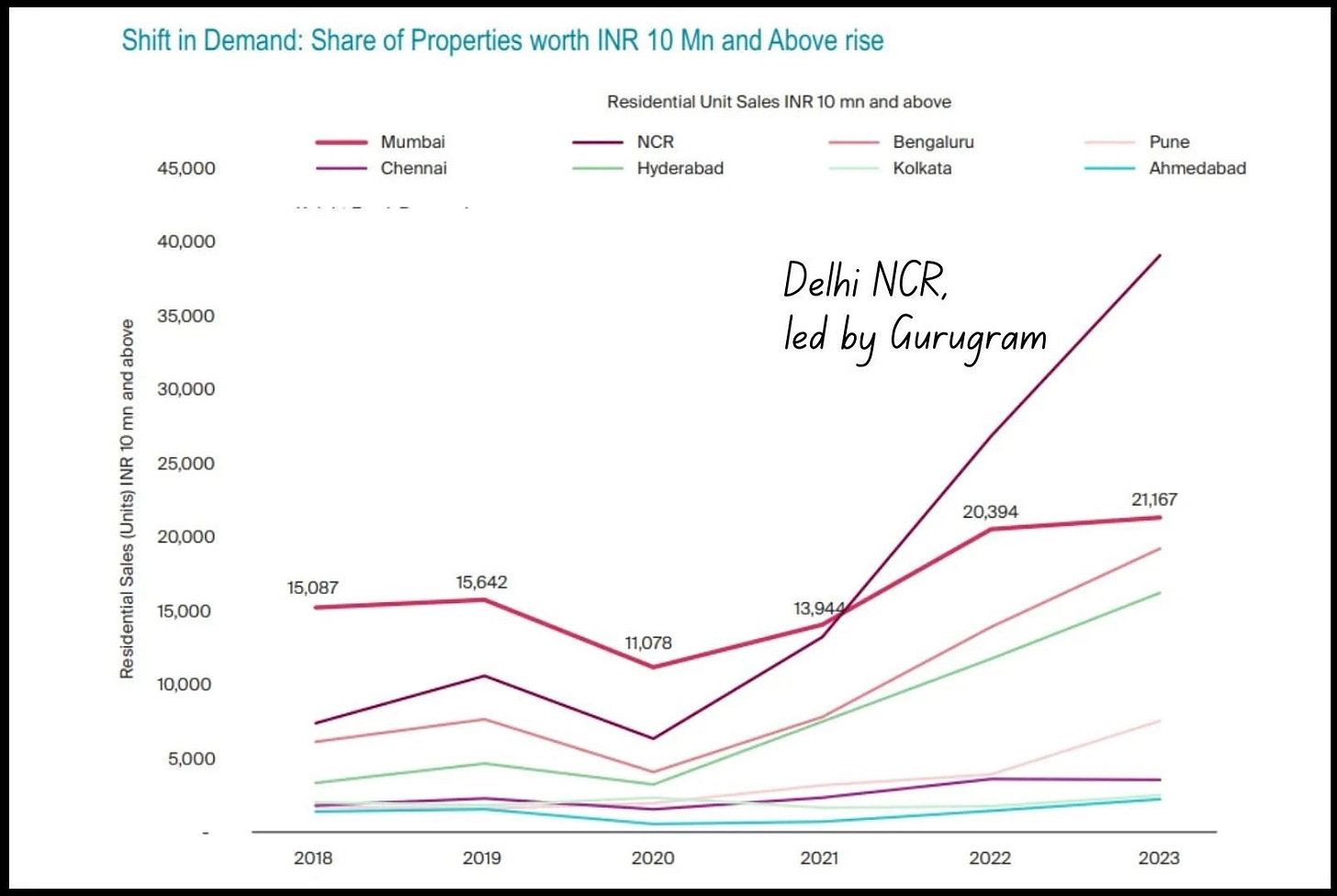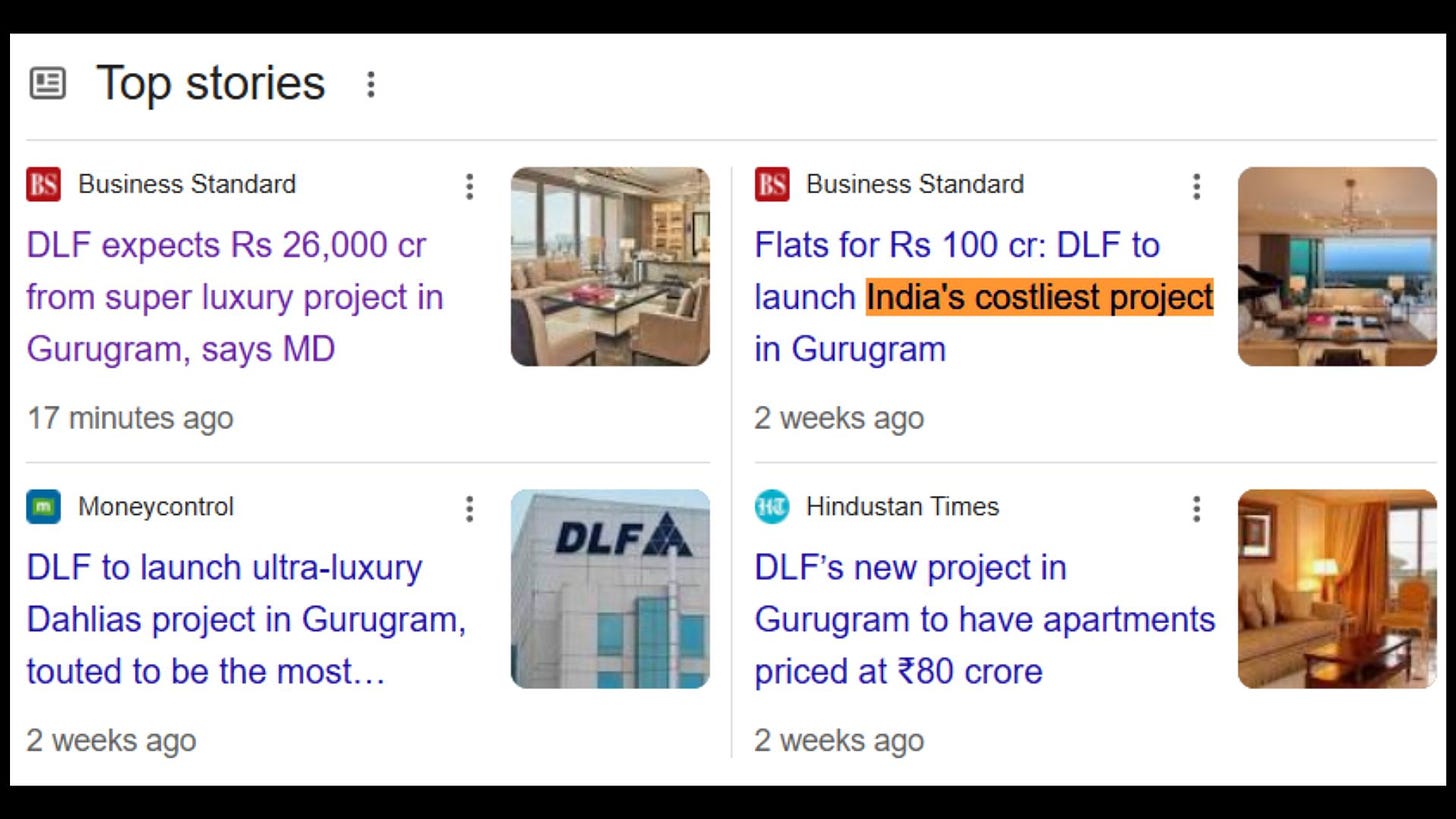The Roaring Gurugram!
Lack of alternatives makes a strong case for a prolonged property market boom.
Hey there!
Last month we published our blog ‘No Permissions Required!’ in which we discussed the instances where Tata Power has demonstrated close proximity to the government across various timelines and levels, with minimal impact from changing political landscapes.
From Power to Real Estate, today we are discussing how Gurugram is poised for success despite the challenges it faces. Our goal is to convince readers that Gurugram has the potential to give Mumbai’s property market a run for its money.
Let’s get started!
Gurugram: The money spinner!
Having lived in Gurugram for the past 3 years, I’ve noticed that it’s rare to meet someone who was originally “born” in the city. Most people I’ve encountered either have families who previously lived in New Delhi (or a nearby city) and moved here in the last 10-15 years, or they came from other cities to work here many years ago and eventually settled down, or currently living on rent. There is hardly any "original/native" population in the city, because just 30 years ago, Gurugram was primarily a collection of villages and towns, with 92% of the district's land being agricultural. But now, that figure has dropped to around 40%.
This cluster of villages, located next to India’s national capital, New Delhi, in northern India, has transformed into a symbol of luxury and a hotspot for investment. It has attracted global firms to relocate their offices to India. Its proximity to India’s busiest airport, Indira Gandhi International (IGI) Airport, connectivity via NH8, Dwarka Expressway, and Golf Course Road, along with the presence of DLF—India’s largest real estate developer in both the commercial and residential sectors—has been a key factor in attracting more than ~350 of the Fortune 500 companies to call this city their home.
This symbol of luxury is becoming so prominent that Gurugram alone surpassed Mumbai last year in terms of the number of properties sold with a price tag of INR 1 crore or more (chart below). While Mumbai has been India’s largest real estate market since Independence, this development could be significant if it continues. In fact, over the past two years, the entire New Delhi ‘National Capital Region - NCR’ (including Gurugram and Noida) has comfortably held the top position in India, with the majority of high-value deals occurring in Gurugram, according to research from Knight Frank India.
With "Luxury" and "Gurugram" becoming synonymous, India’s largest developer is taking things up a notch by launching the country’s most expensive project here. As of October 2024, flats in the first phase of this project start at around INR 70 crores, with the potential to reach ~INR 100 crores in upcoming phases over the next few months. The project, named ‘DLF Dahlias’ will feature ~420 yet-to-be-constructed flats. Mumbai’s property market has never seen anything on this scale.
“Our existing customers always back us with strong support & we continue to mine every day our NRI business which had earlier grown from 3% to 8% to now 28% (of total bookings)”
- Aakash Ohri, Joint MD & CBO, DLF (Investor Con-call, Oct ’24)
Gurugram on Fire🔥: Is this Sustainable?
While Gurugram remains the hotspot for nearly all listed property developers in India, the bigger question is whether this trend is sustainable in the long term. I believe it is!
1. Lack of Clear Alternative
When examining the Indian map and plotting the top 8-10 cities that represent the biggest real estate markets in the country, a stark realization emerges: in North + Central + Eastern India (the white portion), there are hardly any true metropolitan alternatives to the Delhi NCR region. In contrast, the southern half of India (the shaded portion) boasts Mumbai, Pune, Hyderabad, Bengaluru, and Chennai, all relatively close to each other.
With the rising aspirations of modern India—driven by a hunger for opportunities, better facilities, greater comfort, and a luxury lifestyle—wealthier individuals from Tier 2 cities and beyond often seek to migrate to Tier 1 cities.
“We don’t only have buyers from Delhi NCR, but also families from Tier 2 - Kanpur, Bhubaneswar buying ‘Camellias’ to experience the lifestyle that Gurugram offers”
- Aakash Ohri, Joint MD & CBO, DLF (Investor Con-call, Oct ’24)
These structural contributors are not just a 1-2 year phenomenon; they can last for decades. While there is undoubtedly a degree of subjectivity involved, another aspect that specifically benefits Gurugram is the Delhi NCR region itself, which has a total population of ~ 3.2 crore, with only a small portion calling Gurugram home yet. As a result, a significant demand continues to come from core Delhi residents seeking better amenities and lifestyles, often leading them to shift to the premium societies of Gurugram.
2. Opening an office in Gurugram - a necessity?
The under-construction office building you see in my background is Block 4 of DLF Downtown, Gurugram, which is expected to be commissioned by mid-2025. An interesting fact about this building is that at the beginning of 2023, Amazon India had already committed to leasing 3.38 lakh sq ft (four complete floors) once construction and fit-outs are complete.
With this expansion, Amazon would roughly 2.5 times its total presence in Gurugram, having already occupied ~2 lakh sq ft of office space in nearby Ambience Tower 2.
Amazon is a prime example of a company choosing Gurugram for its expansion into the North, Central, and Eastern regions of India, following a significant presence in Hyderabad and Bengaluru. Similarly, Air India is relocating many of its staff from across India to its new headquarters at Vatika One-on-One in Gurugram as it merges Vistara and Air India Express.
Additionally, in May 2024, American Express opened its 5th office in Gurugram, which is also their largest self-built office in world, located in Sector 74, and is now estimated to house around 20,000 employees.
"Our new India campus is the largest office we’ve built from the ground up globally”
- Gagandeep Singh, Senior VP, American Express (May, 2024)
Back in 2015, it was estimated that ~250 of the Fortune 500 companies called Gurugram their home. Today, that number has increased to ~350 as per an estimate, making it an increasingly attractive choice for companies entering or expanding within India.
As part of the Delhi NCR, Gurugram has access to a rich talent pool from prestigious institutions like IIT Delhi, DTU, IIIT Delhi, FMS, MDI, and exceptionally talented students from Delhi University, which is considered the best universities in India, especially for undergraduates, where companies prefer to hire directly from these campuses. Furthermore, among India’s major corporate cities, Delhi NCR boasts the largest population, with approximately 3.2 crore, compared to Mumbai’s 2.2 crore, Bengaluru’s 1.4 crore, Hyderabad’s 1.1 crore, and Pune’s 0.7 crore. This large population base serves as a target audience for startups. For instance, Delhi NCR contributes contributes ~40% of sales done by Blinkit (India’s largest quick commerce company).
3. Within NCR, the downfall of the Noida market
Due to the core Delhi city area having its own set of government restrictions and a very limited land bank for further development, offices and residents are primarily left to choose between the two adjacent options: Gurugram and Noida. However, the Noida market has faced its own set of challenges that have troubled home buyers for over a decade.
The fortunes of a city are often defined by the quality of its builders and the integrity of the governing authorities. When builders prioritize profit and authorities are corrupt, a city’s progress can be set back by several years, if not decades. Let’s take a look at what has happened with the Noida/Greater Noida real estate market.
On 28th August 2022, the famous 'Twin Towers' of Noida by a prominent builder in the country named ‘Supertech’ were demolished due to multiple building norm violations after the Supreme Court had found breaches in minimum distance requirements between buildings and other safety rules. They also found unauthorized construction and collusion with Noida Authority officials.
Being the biggest builder in Noida & Greater Noida, the court order sent a ripple effect across Supertech’s ~40 projects in the region on 300+ acres of land. After the incident, it became very difficult for the builder to clear its existing inventory and launch any new project. And hence recently in June 2024, NCLT ordered bankruptcy proceedings against another Supertech's project - 'Supernova', which was also the tallest building of the whole North India with 80 floors under construction.
Further in July 2024, the Comptroller and Auditor General (CAG) of India uncovered significant irregularities within the NOIDA Authority, leading to staggering losses. The report highlights a nexus between officials and builders, resulting in improper land allotments and approvals between 2005 and 2014, severely impacting the state’s exchequer.
On the other hand, Gurugram also faced the bankruptcies of a few builders like IREO but the biggest builder DLF stood strong through the tough times and the downturn of last decade. This has directly benefitted the Gurgaon region with greater buyer confidence leading to the highest price appreciation once the market turned post covid. As per the latest Knight Frank reports, out of the total Real Estate deals happening post-covid in the whole Delhi NCR region, about 50% have actually happened in Gurugram alone, whereas early 50%+ share used to be of Noida + Greater Noida's in the pre-covid era. So the tables have turned post covid.
My Take:
Gurugram has several fundamental factors supporting its long-term growth, and it has benefited from a lack of alternatives in the upper half of India's geography. This makes it a prime location for most global corporates, as more employees move to and settle in a city that has very few native residents. Additionally, Noida’s decline as a potential market for homebuyers and businesses has significantly contributed to the momentum Gurugram is currently experiencing and can continue to enjoy for years to come.
However, several challenges remain, posing potential risks, including poor development planning in many areas of Gurugram and significant air pollution issues during certain months of the year.
Despite these risks, I am excited about the future of Gurugram and my investment in DLF shares. That’s it for today!
Finding Outperformers is a free-to-access website, and each blog takes a month of effort to finalize. If you've read this far and you find our research useful, consider supporting our efforts by contributing here:
Connect with me on LinkedIn here. Find our recent blogs on similar lines:
Disclaimers-
We are not a SEBI registered advisor; personal investment/interest in the shares exists for the company mentioned above; this isn’t investment advice but my personal thought process; DYOR (do your own research) is recommended; Investing & trading are subject to market risk; the decision maker is responsible for any outcome.













